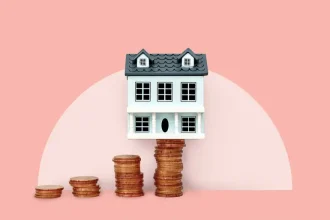Key takeaways
- To get the best mortgage rate, boost your credit score, lower your debt and save up a sizable down payment.
- Getting the best mortgage rate can save you thousands of dollars in interest over the life of the loan.
- Shop around for the best mortgage rate with at least three lenders and compare quotes.
While mortgage rates are actually lower than average historically, they’ve increased quite a bit from a few years ago, making homebuyers’ monthly payments more expensive.
Interest rates depend largely on the broader economy, but there are still steps you can take to get the best mortgage rate possible — and save money on your loan over time.
8 steps to get the best mortgage rates
1. Improve your credit score
Boosting your credit score is a great first step to getting a lower mortgage interest rate.
“A credit score is always an important factor in determining risk,” says Valerie Saunders, past president of the National Association of Mortgage Brokers (NAMB). “A lender is going to use the score as a benchmark in deciding a person’s ability to repay the debt. The higher the score, the higher the likelihood that the borrower will not default.”
To be considered for a conventional mortgage, you’ll generally need a score of 620 or higher. However, the best mortgage rates go to borrowers with credit scores of 740 or above.
To improve your score, pay your bills on time and pay down or eliminate credit card balances. If you must carry a balance, make sure it’s no more than 20 percent to 30 percent of your available credit limit. Also, check your credit score and report regularly and look for any mistakes. If you find errors, correct them before applying for a mortgage.
2. Build a steady employment record
Lenders prefer you to have at least two years of steady employment and earnings, ideally from the same employer, before applying for a mortgage. Be prepared to show pay stubs from at least 30 days prior to your mortgage application and W-2s from the past two years. If you earn bonuses or commissions, you’ll need to provide proof of those as well.
It can be more difficult to qualify if you’re self-employed or have multiple part-time jobs, but it’s not impossible. If you’re self-employed, you might need to furnish business records, such as profit and loss statements, in addition to tax returns, to round out your mortgage application.
What if you’re a graduate just starting your career, or you’re back in the workforce after time away? Lenders can usually verify your employment if you have a formal job offer, so long as it includes your income. The same applies if you’re currently employed but have a new job lined up. Lenders might flag your application if you’re switching to a completely new industry, however.
Gaps in your work history won’t necessarily disqualify you, but the length of those gaps matters. A short period of unemployment due to illness is easier to explain to a lender than, say, unemployment of six months or more.
3. Save up for a down payment
Putting more money down — ideally, at least 20 percent — can help you get a lower mortgage rate. Of course, lenders accept lower down payments, but putting down less than 20 percent usually means you’ll pay more in interest, and you’ll have to pay private mortgage insurance (PMI). PMI costs about $30 to $70 per month for every $100,000 borrowed, according to Freddie Mac. The sooner you can pay down your mortgage to less than 80 percent of the total value of your home, the sooner you can get rid of mortgage insurance, reducing your monthly bill.
4. Understand your debt-to-income ratio
Your debt-to-income (DTI) ratio compares your total monthly debt payments to your gross monthly income.
In general, lenders prefer your mortgage payments take up no more than 28 percent of your gross monthly income, and that your mortgage and other debt payments total no more than 36 percent of your monthly income. For a conventional loan, lenders may approve DTI ratios of up to 45 percent. This is more likely if you have significant savings or a strong financial profile otherwise.
If you make $5,000 per month, you’ll want a mortgage payment of no more than $1,400 ($5,000 x 0.28). Your mortgage and other debt payments should ideally remain below $1,800 ($5,000 x 0.36).
You can improve your DTI by increasing your income or paying off debt.
Debt-to-income ratio calculator
A debt-to-income, or DTI, ratio is calculated by dividing your monthly debt payments by your monthly gross income.
Calculate your debt-to-income ratio
5. Check out different mortgage loan types and terms
If you think you’ve found your long-term home and have good cash flow, consider a 15-year, fixed-rate mortgage instead of the traditional 30-year, fixed-rate mortgage. You’ll pay more each month, but you’ll pay off your home sooner. Plus, you’ll pay less in interest since interest rates on 15-year mortgages tend to be lower than those of other mortgage options. You can also choose a 15-year term if you’re refinancing your current mortgage.
Alternatively, you might consider an adjustable-rate mortgage (ARM). With these types of loans, you’ll start with a fixed rate for a set time — often five or seven years — which is typically lower than what you’d get with a fixed-rate mortgage. After this period ends, your interest rate can increase or decrease for the remainder of the term. Before that happens, or whenever rates fall, you could refinance an ARM loan into a fixed-rate mortgage.
Government-backed loans may also offer lower rates than conventional loans. Your options include:
- FHA loans: Insured by the Federal Housing Administration, FHA loans are popular with first-time homebuyers because of their flexible financial requirements.
- VA loans: If you or your spouse have served in the military, you could consider a VA loan, which is guaranteed by the U.S. Department of Veterans Affairs. These loans typically have no down payment requirement.
- USDA loans: Guaranteed by the U.S. Department of Agriculture, the USDA loan program is designed to help low- and moderate-income people in rural areas buy a home. There’s no down payment needed, but your home must be in an eligible area, and your income cannot exceed a certain amount, based on your location and household size.
Keep in mind that some state and local government programs aimed at first-time homebuyers also charge below-average interest rates.
6. Consider paying mortgage points
If you’re willing to pay a fee, you can buy your way to a lower interest rate using mortgage points. Each point costs 1 percent of your mortgage amount and typically reduces your interest rate by 0.25 percent. You can think of mortgage points as a form of prepaid interest.
Let’s say that you have a $400,000 home loan with a 7 percent interest rate. If you want a lower rate, you could buy a mortgage point for $4,000 and knock your rate down to 6.75 percent.
However, buying mortgage points isn’t right for everyone. Recouping the upfront costs typically takes around five years, so this strategy isn’t ideal if you plan on selling within that time.
7. Compare offers from multiple mortgage lenders
When you’re looking for a mortgage, even for a refinance, don’t accept the first rate you’re quoted. Shop around with at least three lenders, including your own bank or credit union and at least one online option.
“Shop and compare based on the loan estimates received,” Saunders says. “You wouldn’t normally purchase a car without test-driving it first. Test drive your loan before proceeding with your purchase.”
Even if the interest rates are comparable, lenders’ offers come with different fees, closing costs, private mortgage insurance premiums and more. By shopping around, you can choose the offer with the most favorable terms.
Before choosing a lender, you should also read their mortgage lender reviews to see what other consumers think. And if you’re not sure where to start, consider comparing mortgage rates on Bankrate, where you can view multiple offers in minutes.

Best mortgage lenders of 2025
The best mortgage lenders based on affordability, availability and borrower experience.
Learn more
8. Lock in your mortgage rate
Sometimes the closing process takes several weeks, during which rates can fluctuate. After you sign the home purchase agreement, ask your lender to lock your rate. The service sometimes comes with a fee, but it often pays for itself, especially in volatile rate environments.
How much could you save with a lower mortgage rate?
How much could shopping around for mortgage rates really save you? Check out the chart below to see how the savings can add up on a $350,000 home loan with a 30-year, fixed mortgage.
| Mortgage rate | Monthly mortgage payment* | Total cost of the loan |
|---|---|---|
| 7.0% | $2,329 | $838,281 |
| 6.75% | $2,270 | $817,234 |
| 6.5% | $2,212 | $796,406 |
| 6.25% | $2,160 | $775,804 |
| 6.0% | $2,098 | $755,434 |
| *Includes only principal and interest | ||
Market factors that affect your mortgage rate
Mortgage rates change often based on a few factors, including:
- Inflation and other economic conditions. While the Federal Reserve doesn’t directly set mortgage rates, its policy certainly affects the cost of your loan. The Fed may increase or decrease rates in an effort to slow inflation or spur growth, and these moves can indirectly translate to higher or lower mortgage rates.
- 10-year Treasury yields. Mortgage rates move with 10-year Treasury bond yields, which, in turn, are based on investor sentiment and economic trends.
Want to stay up-to-date with on rates and get more tips on how to shop for a mortgage? Get the latest with Bankrate’s daily mortgage news stories and weekly analyses.
Next steps to close on your mortgage
Now that you know how to get the best mortgage rate, it’s time to choose the best loan offer and apply for the loan. Here’s an overview of what you can expect during this process:
- Get your loan estimate: Within three days of applying, you’ll get a loan estimate, which spells out the details of the mortgage. This includes a list of closing costs, but bear in mind these are only estimates, not the final numbers. If you have any questions about what’s in your loan estimate, ask your lender for clarification.
- Undergo underwriting: Your lender’s underwriting department will review your application to determine whether to approve your mortgage. During this time, you might be asked to provide more documentation or answer questions, so be prepared and responsive. Maintain your financial and employment situation, too — don’t apply for any new credit cards or loans, make large purchases or switch jobs, if you can help it.
- Wait for approval: If your mortgage is approved, you’ll be on your way to closing. If your mortgage is denied, it’s important to find out what influenced the decision. Generally, you can reapply for another mortgage with another lender as soon as you want, but it might make sense to wait for a few months so you don’t harm your credit.
As you near your closing date, you’ll receive a closing disclosure with the finalized loan terms, including your interest rate and closing costs. Be sure the numbers in this document match the figures you were originally quoted. Keep in mind that rate locks usually apply only for a set time, so it’s best to work with your lender to avoid delays on the road to closing.
FAQ
Why we ask for feedback
Your feedback helps us improve our content and services. It takes less than a minute to
complete.
Your responses are anonymous and will only be used for improving our website.
Help us improve our content
Read the full article here














